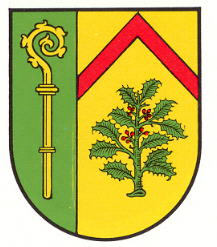Hilst: Difference between revisions
Jump to navigation
Jump to search
Knorrepoes (talk | contribs) No edit summary |
Knorrepoes (talk | contribs) m (Text replace - "[[Literature" to "{{media}} [[Literature") |
||
| Line 21: | Line 21: | ||
The chevron is taken from the arms of the Counts of [[Hanau]]-Lichtenberg, who ruled the area for a long period of time until 1793. The crosier is taken as a symbol for the Stürzelbronn Abbey, which had many possessions in the village. The holly is a canting element, the name is derived from Hulis, which resembled the medieval German word for holly (now it is Stechpalme, but in Dutch still hulst). | The chevron is taken from the arms of the Counts of [[Hanau]]-Lichtenberg, who ruled the area for a long period of time until 1793. The crosier is taken as a symbol for the Stürzelbronn Abbey, which had many possessions in the village. The holly is a canting element, the name is derived from Hulis, which resembled the medieval German word for holly (now it is Stechpalme, but in Dutch still hulst). | ||
{{media}} | |||
[[Literature]] : Debus, 1988 | [[Literature]] : Debus, 1988 | ||
Revision as of 22:52, 8 July 2014
| Heraldry of the World Civic heraldry of Germany - Deutsche Wappen (Gemeindewappen/Kreiswappen) |
HILST
State : Rheinland-Pfalz
District (Kreis) : Südwestpfalz
Verbandsgemeinde : Verbandsgemeinde Pirmasens-Land
Official blazon
Origin/meaning
The arms were officially granted on December 20, 1984.
The chevron is taken from the arms of the Counts of Hanau-Lichtenberg, who ruled the area for a long period of time until 1793. The crosier is taken as a symbol for the Stürzelbronn Abbey, which had many possessions in the village. The holly is a canting element, the name is derived from Hulis, which resembled the medieval German word for holly (now it is Stechpalme, but in Dutch still hulst).
Contact and Support
Partners:
Your logo here ?
Contact us
© since 1995, Heraldry of the World, Ralf Hartemink 
Index of the site
Literature : Debus, 1988











